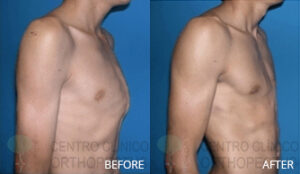The deformities of the anterior chest wall are known as pectus carinatum or “pigeon breast” and pectus excavatum or “shoemaker chest”. They are very common, affecting millions of people around the world, but remain hidden from society because people who have these deformities are usually ashamed of their chest aspect, avoiding clothing and activities that make these deformities noticeable.
Pectus deformities are very common and they are not only a cosmetic problem. They also imply psychological problems to the patients and their families, deserving a rational approach and a social discussion for the benefit of people who have the condition.
Clinically, close to 6000 patients were observed by Haje S., Haje D. and Silva from 1977 to October 2016 in our center (Orthopectus). As pectus deformities are varied, and many times aesthetically different from each other, but with a common causal factor – disturbances in the formation and in the growth of the anterior chest wall bones and cartilages (see our article). Common factors may be involved in its pathogenesis: heredity, spine mal-alignment like scoliosis and/or increased thoracic kyphosis, and a common psychological profile that aggravates with the adolescence growth spurt and the natural increase of the deformity due to the chest wall bones and cartilages disproportional growth.
In 1990/91 Haje and colleagues conducted an experiment that resulted, for the first time in history of Medicine (see our article), in reproduction of pectus deformities in animals, suggesting that these deformities occur due to a disproportion between the growth of the sternum (chest bone) and costal arches (costal cartilages and ribs). The psychological impact of a pectus deformity can be devastating on a patient and this impact is not always related to the severity of the deformity. Feelings of frustration can increase with medical suggestion to accept the deformity or just try a surgical solution.


- bemadminhttps://orthopectus.com.br/eng/author/bemadmin/
- bemadminhttps://orthopectus.com.br/eng/author/bemadmin/
- bemadminhttps://orthopectus.com.br/eng/author/bemadmin/

